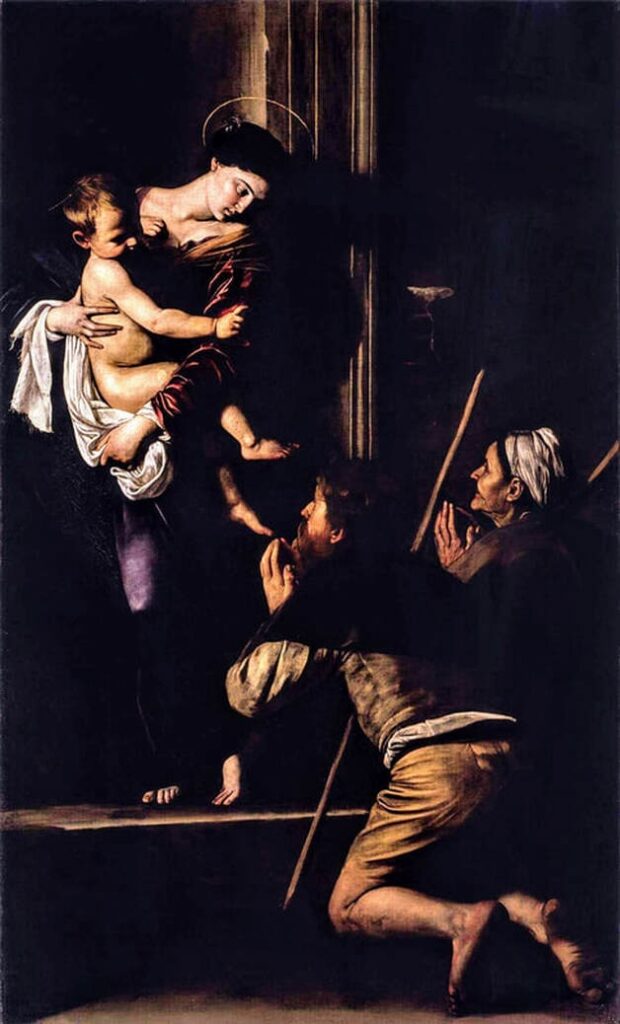It could almost be a riddle: What’s the difference between a pilgrimage and synodality? Almost. There’s a long, legitimate place for synods in the life of the Church (“synodality,” by contrast, is quite a different and doubtful thing, since no one seems to be able to say what it is, or isn’t, other than more people talking). So, there need not be an opposition, much less a division, between a synod and the equally legitimate – and even longer – tradition of pilgrimage. But nota bene: in this man’s view, if you want real “walking together,” it’s best found on foot, body and soul on the way together – in the midst of God’s Creation – rather than sitting and talking, for hours, days, weeks, a month around tables in a large conference hall.
A pilgrimage has the further advantage of a journey to a specific destination for a clear purpose, not a perpetual “process.” Jesus, Mary, and Joseph made the pilgrimage to Jerusalem together at least once (that we know of) when the boy Jesus was lost and later found in the Temple with the learned rabbis. (Luke 2:41-49) In His day, Jewish men – following an already centuries-old tradition – were supposed to make the pilgrimage to Jerusalem three times a year (Passover, Pentecost, Sukkoth). That’s what he was also doing when He presented Himself to be crucified.
People go on pilgrimage for all sorts of reasons. Besides the Jews, even ancient Greeks and Romans made pilgrimages to places like Delphi or Epidaurus (the Lourdes of the classical world). There’s Mecca, of course, for Muslims. And Buddhist and Hindu sites all over Asia. There’s something about this impulse to leave home – not permanently, but on a journey that will take you to a “home” of a different order than the everyday one, from which – if all goes well – you bring back something that enhances, even reveals unsuspected depths in your ordinary dwelling place.
T.S. Eliot is getting at that here:
We shall not cease from exploration
And the end of all our exploring
Will be to arrive where we started
And know the place for the first time.
That may overstate the case somewhat, as poets sometimes do, because we’re on yet another pilgrimage in this life, even after having done a spiritual pilgrimage to some holy place. But he’s got it right that there’s a dynamic relationship between home and pilgrimage destination – and the travel in between – that human beings in very different faiths and cultures refuse to do without.
It takes time and tradition, though, to make a pilgrim way: something both familiar and open-ended. Both are important because mere wandering – like mere talking – is not a pilgrimage. And it is also just an ordinary trip if all you’re doing is going to some place where everything is predictable beforehand.

While each pilgrim and each pilgrimage is unique and therefore partly unpredictable, the most profound pilgrimages usually follow along routes already trodden by numberless earlier pilgrims. There are numerous Christian pilgrimages in Europe and Latin America that no one but locals have ever heard of, often stretching back in time, which – paradoxically – only seems to bring something fresh and new to an old track.
People go on pilgrimage even in big, sprawling countries like America. When I mentioned the importance of pilgrimages in a column last year, TCT received about 75 messages about local American pilgrimages, most of which I’d never heard of. I’ll be doing one of those for the second time in Florida later this week between Jacksonville and St. Augustine: 30 miles in three days with hundreds of other people. The Florida Camino now has a formal relationship to the Camino to Santiago de Compostela in Spain, one of the largest Christian pilgrimage sites. You can even “earn miles” here towards your pilgrim’s “passport” there. (We’ve done a TCT podcast – click here – with Tom and Susan Egan, who created and organize the whole thing.)
Anyone who’s been on pilgrimage knows the anticipation of moving out into something bigger than the everyday – which is the initial attraction – that will open up many new avenues. Bilbo’s song in The Hobbit is a perfect example:
The Road goes ever on and on,
Down from the door where it began.
Now far ahead the Road has gone,
And I must follow, if I can,
Pursuing it with eager feet,
Until it joins some larger way
Where many paths and errands meet.
And whither then? I cannot say.
Of course, the greatest pilgrimage is the one we’re all on whether we wish to be or not, the journey towards our ultimate destiny. Lots of Christians these days are all too confident that everyone goes to Heaven. But as Hebrews puts it, “It is a fearful thing to fall into the hands of the living God.”
In the first pages of the greatest Christian poem ever written, Dante’s Divine Comedy, Dante the pilgrim has hesitations about the pilgrimage he’s about to make to the next world. There have been – yes – great examples, he tells his guide Virgil, like Aeneas (who founded Rome) and St. Paul (the Apostle to the Gentiles) who were permitted to see the afterlife:
‘But why should I go there? who allows it?
I am not Aeneas, nor am I Paul.
Neither I nor any think me fit for this.
And he gets a blunt response that we should all take to heart:
‘If I have rightly understood your words,’
replied the shade of that great soul,
‘your spirit is assailed by cowardice,
‘which many a time so weighs upon a man
it turns him back from noble enterprise.
I’ve done pilgrimages almost yearly for a decade. They’re not only personally enriching but an important part of bringing the Faith into the public square. Demonstrations, protests, political rallies are important, as are processions and prayer vigils. But on pilgrimage, you not only benefit yourself, but other wayfarers – and even a world deep asleep in the belief that it’s “woke.”

















